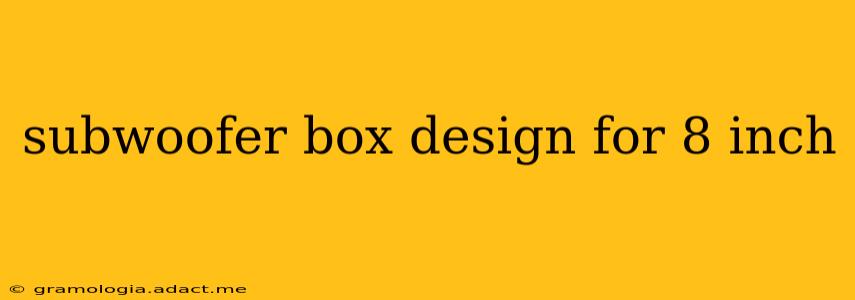Choosing the right subwoofer box is crucial for achieving optimal bass response from your 8-inch driver. A poorly designed enclosure can severely limit the subwoofer's potential, resulting in weak, muddy bass or even damage to the driver itself. This comprehensive guide will explore various design considerations and help you select or build the perfect enclosure for your 8-inch subwoofer.
What are the Different Types of Subwoofer Enclosures?
Several enclosure types cater to different preferences and acoustic goals. The most common include:
-
Sealed (Acoustic Suspension): These enclosures are airtight and simple to build. They offer accurate, tight bass with controlled excursion but generally produce less output at lower frequencies compared to ported designs. Ideal for smaller spaces and applications where precision is paramount.
-
Ported (Bass Reflex): Ported boxes utilize a port (tube) to enhance bass output by resonating with the driver. They produce louder bass, extending the low-frequency response, but can be more challenging to design and may exhibit port noise or chuffing if not designed correctly. Excellent for home theaters and systems needing powerful bass.
-
Bandpass: These are more complex designs with two chambers and two ports, offering a narrow frequency response peak. While achieving extremely high output in a specific frequency range, they are less versatile and can be difficult to tune.
-
Horn: Horn-loaded subwoofers are highly efficient but require significant space and expertise to design and build. They are typically used in professional audio applications.
What are the Key Design Considerations?
Several factors influence the performance of your 8-inch subwoofer enclosure:
-
Driver Specifications: The manufacturer's specifications for your specific 8-inch driver are crucial. Pay close attention to the recommended enclosure type, volume, and tuning frequency (for ported designs). Ignoring these recommendations can lead to poor performance or driver damage.
-
Enclosure Volume: The internal volume of the box directly impacts the low-frequency response. Too small, and the bass will be weak; too large, and the bass may become loose and uncontrolled. The ideal volume is usually specified by the driver manufacturer.
-
Tuning Frequency (for Ported Boxes): This determines the frequency at which the port resonates, influencing the overall bass response. It's critical to calculate the correct port length and diameter to achieve the desired tuning frequency. Software programs and online calculators can assist with this calculation.
-
Internal Bracing: Adding bracing inside the enclosure stiffens the box, reducing unwanted vibrations and improving the overall sound quality.
-
Port Design (for Ported Boxes): The port's length, diameter, and shape affect the airflow and the tuning frequency. Sharp edges should be avoided to minimize turbulence and noise.
-
Materials: Use high-density materials like MDF (medium-density fiberboard) for the enclosure construction to minimize resonance and unwanted vibrations.
How do I choose the right box design for my 8-inch subwoofer?
The best design depends on your priorities and available space:
- Need maximum output and can handle a larger box? Choose a ported design.
- Prioritize accuracy and tight bass in a smaller space? A sealed enclosure is the better option.
- Limited space and building skills? A pre-built sealed or ported enclosure may be the easiest solution.
What are the common mistakes to avoid when designing a subwoofer box?
- Ignoring the manufacturer's recommendations: Always consult your driver's specifications.
- Using the wrong materials: Avoid materials that easily resonate or vibrate.
- Poor port design (for ported boxes): Incorrect port length or diameter can lead to poor bass response or port noise.
- Insufficient internal bracing: This can lead to unwanted resonances and a muddy sound.
- Poor sealing: Leaks in the enclosure will compromise the performance.
What software can I use to design my subwoofer box?
Several software programs can help you design subwoofer enclosures, calculating the necessary dimensions and port parameters. WinISD and BassBox Pro are popular choices among enthusiasts.
Can I build a subwoofer box myself?
Yes, building a subwoofer box is achievable with basic woodworking skills and the right tools. Many online tutorials and guides provide step-by-step instructions. However, if you lack experience, purchasing a pre-built enclosure is a simpler alternative.
By carefully considering these factors and utilizing available design tools, you can create or select the ideal subwoofer enclosure to unleash the full potential of your 8-inch driver and enjoy rich, powerful bass. Remember, accurate measurements and a meticulous approach are key to success.
